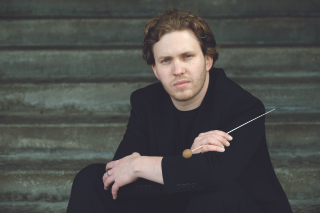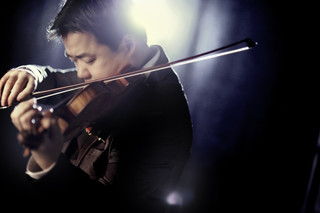|
Back
Scotland’s blustery awakening Orange County
Renée and Henry Segerstrom Concert Hall
02/02/2017 - & 3, 4 February 2017
Hamish MacCunn: The Land of the Mountain and the Flood, Opus 3
Max Bruch: Scottish Fantasy for Violin and Orchestra, Opus 46
Felix Mendelssohn: Symphony Nº 3 in A minor, Opus 56 “Scottish”
Ning Feng (Violin)
Pacific Symphony, David Danzmayr (Conductor) 
D. Danzmayr (© Courtesy of Pacific Symphony)
Bagpipes wafted in the plaza, beckoning seasoned subscribers into the concert hall, just like skeins of thread magically wound their way onto the stage through composers and performers to create a Scottish tapestry. Though the absence of Carl St. Clair and Concertmaster Raymond Kobler were felt, like resolute Celtsmen hunkering down in their harsh domicile north of Hadrian’s Wall, the Pacific Symphony was anchored and positioned for the often-times rugged and wild music.
Previously serving as Assistant Conductor of the Royal Scottish National Orchestra, debuting David Danzmayr tied together the entire evening’s Caledonian theme with dexterous leadership. Underperformed outside of Scotland, The Land of the Mountain and the Flood is Hamish MacCunn’s lyrically testy clichéd overture that ebbs and flows in fluctuating capacities. Pacific Symphony formulated satisfying imagery with heather-like legato while similarly tussling with Scottish moodiness and Wagnerian tumult. With infrequent swells of Frederick Delius surfacing, the piece finished with Pacific Symphony’s lovely balance of optimistic resolve.

N. Feng (© Lawrence Tsang)
Undoubtedly, the evening’s pinnacle was Max Bruch’s Scottish Fantasy featuring the virtuosities of Ning Feng. Perceptive in this complicated and oft dizzying piece was the communication between Mr. Feng, Maestro Danzmayr and Associate Concertmaster Paul Manaster. Clearly, the latter two took cues from Mr. Feng, allowing him to brighten the hall with his own acrobatics and nimble fretwork. There was a certain playfulness and carefree element in this rendition, a bit of theatrics, a scope of seriousness and a preservation of honor to the composer…conservation prevailed. When the irritatingly loose horse hair pulled out of the bowstring during the energetic “Allegro”, Ning Feng nonchalantly plucked it off between solo sections, and continued unflinchingly, easing doubts of disruption. Though Bruch’s ensuing “Andante sostenuto” could be overreached and destined as saccharine, Mr. Feng repelled that approach by giving the movement heartfelt sincerity and classical Scottish warmth.
The second half of the program was devoted to Felix Mendelssohn. Pacific Symphony’s violins were particularly poignant and appropriately piercing in the “Andante con troppo.” This helped establish broad momentum going into subsequent sections. Mr. Danzmayr delivered an ebullient scherzo beginning with a flouncy clarinet lead, followed by pockets of play between flutes and oboes and eventually tutti orchestra. The finale “Allegro vivacassimo” returned once again to the itchy and tetchy textures from the violins. Tempo driven by the maestro was very apropos.
How did this Scottish Symphony come to deliver such a lasting impression? There is a compelling quotient resting in the hands and arms of Maestro Danzmayr. From this reviewer’s perspective the efforts to coax, prod, nurture and retreat were all executed with integrity and persuasive passion, and this set up Mendelssohn’s Symphony Nº 3 to be exceptionally mesmerizing.
Pacific Symphony Website
Christie Grimstad
|